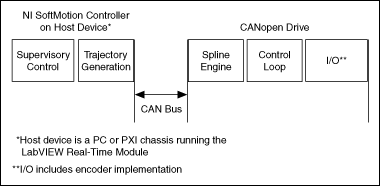NI SoftMotion Controller Architecture
The NI-Motion architecture for the NI SoftMotion Controller uses standard PC-based platforms and open standards to connect intelligent drives to a real-time host. In this architecture, the software components of the motion controller run on a real-time host and all I/O is implemented in the drives. This separation of I/O from the motion controller software components helps to lower system cost and improve reliability by improving connectivity. The CANopen standard is used to connect these components.
When you use the NI SoftMotion Controller with a CANopen device, you can daisy chain up to 15 drives together and connect them to the real-time host. The real-time Process Data Objects (PDOs) defined by the CANopen protocol are used to transfer data between the drives and host.
All I/O required by the motion controller is implemented by CANopen drives that support the Device Profile 402 for Motion Control. Currently, the NI SoftMotion Controller supports only CANopen drives from Copley Controls Corp. When used with CANopen devices, the Supervisory Control and Trajectory Generation components of the NI SoftMotion Controller execute in a real-time environment that is running LabVIEW Real-Time Module (ETS).
If your motion control system uses 8 axes or fewer, the supervisory control and trajectory generation loops execute every 10 milliseconds. If your motion control system uses more than 8 axes, the supervisory control and trajectory generation loops execute every 20 milliseconds. When you use the NI SoftMotion Controller with a CANopen drive, the drive implements the control loop and interpolation, as shown in the following figure.

In this configuration, the I/O and the control loop execute on the CANopen drive. The NI SoftMotion Controller uses an NI-CAN device to communicate to the CAN bus.